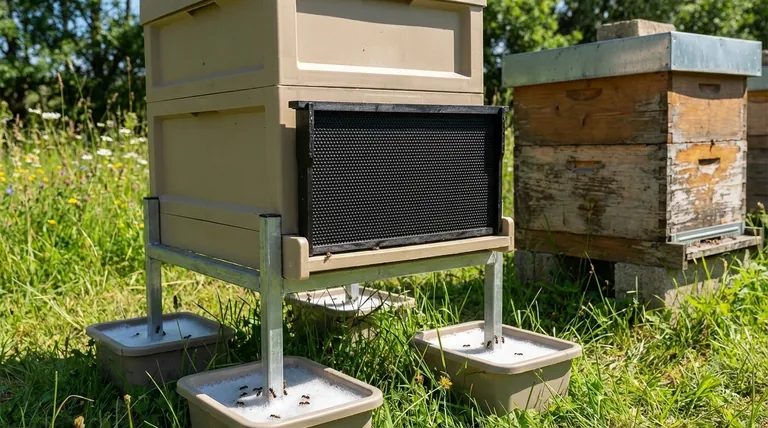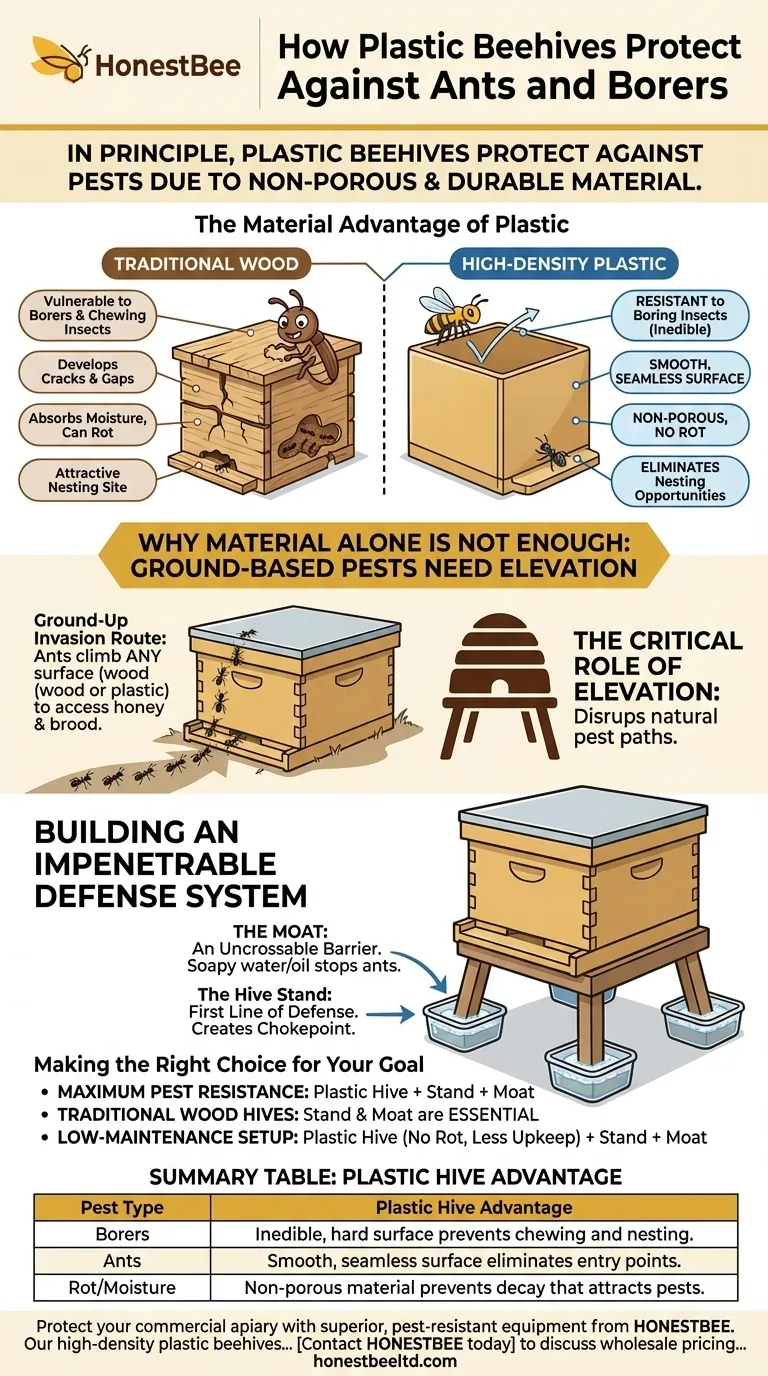In principle, plastic beehives protect against pests due to their non-porous and durable material. Unlike wood, which borers can chew and ants can exploit for nesting, the hard, smooth surface of plastic offers no purchase or food source. This makes the hive body itself inherently more resistant to being compromised by burrowing or chewing insects.
The material of a beehive is only one part of a comprehensive pest defense strategy. While plastic offers inherent resistance, true protection against ground-based pests like ants comes from elevating the hive and implementing physical barriers.

The Material Advantage of Plastic
A key reason beekeepers consider plastic is its resilience. This advantage is most apparent when compared directly to the vulnerabilities of traditional wood.
Resistance to Boring Insects
Wood borers and similar pests target wood as a food source or a place to nest. Plastic is an inert, synthetic polymer that is inedible and typically too hard for these insects to chew through.
This completely removes the threat of the hive's structure being weakened from the inside by wood-destroying organisms.
A Non-Porous, Seamless Surface
A primary weakness of wooden hives is their tendency to develop cracks, checks, and gaps as the wood ages and weathers. Ants and other small pests are experts at finding and exploiting these tiny entry points.
High-density plastic is smooth and non-porous. It provides no natural crevices for pests to grip or squeeze through, presenting a much more formidable barrier.
Eliminating Nesting Opportunities
Over time, wood can absorb moisture and begin to soften or rot, especially at the base. This compromised wood can become an attractive nesting site for a satellite ant colony.
Plastic does not rot or decompose. It offers no incentive for ants to establish a nest within the hive body itself, forcing them to look elsewhere.
Why Material Alone Is Not Enough
Relying solely on a plastic hive to stop ants is a critical mistake. Ants are motivated by the scent of honey, brood, and pollen inside the hive, and they will climb any surface to get to it.
The Ground-Up Invasion Route
Ants are ground-based foragers. Their primary method of entry is to simply walk from the ground up the side of the hive and in through the entrance.
The material of the hive box is irrelevant to this invasion route. An ant can climb plastic just as easily as it can climb wood.
The Critical Role of Elevation
The single most effective step in pest management is elevating the hive off the ground with a dedicated hive stand.
Raising the hive forces pests like ants, mice, and skunks to expose themselves by climbing the legs of the stand. This small act disrupts their natural path and is the foundation of any effective defense.
Building an Impenetrable Defense System
True protection comes from creating a layered system. The hive material is one layer, but the stand and other barriers are equally, if not more, important.
The Hive Stand: Your First Line of Defense
A hive stand is not optional if you are serious about pest control. By creating distance between the hive and the ground, you create a chokepoint for pest defense.
The Moat: An Uncrossable Barrier
For complete ant protection, place the legs of your hive stand into small containers of soapy water or non-toxic mineral oil. This creates a moat that ants cannot cross.
The soap breaks the surface tension of the water, causing the ants to sink immediately. This simple, inexpensive trick is nearly 100% effective at stopping ant invasions, regardless of hive material.
Making the Right Choice for Your Goal
Your choice of equipment should support a complete pest management system, not just a single feature.
- If your primary focus is maximum pest resistance: Use a plastic hive elevated on a stand whose legs are placed in oil or soapy water moats. This combines material resilience with a superior external defense.
- If you are using traditional wooden hives: Elevating them on a stand with a moat system is absolutely essential, as wood is more vulnerable to both pests and ground moisture.
- If your goal is a low-maintenance setup: A plastic hive requires less upkeep (no painting, no rot) and, when combined with a stand and moat, provides a robust and long-lasting defense against common pests.
Ultimately, effective pest management relies on a strategic system, not just a single material choice.
Summary Table:
| Pest Type | Plastic Hive Advantage |
|---|---|
| Borers | Inedible, hard surface prevents chewing and nesting. |
| Ants | Smooth, seamless surface eliminates entry points. |
| Rot/Moisture | Non-porous material prevents decay that attracts pests. |
Protect your commercial apiary with superior, pest-resistant equipment from HONESTBEE.
Our high-density plastic beehives provide a durable, non-porous foundation that is inherently resistant to wood borers and eliminates nesting opportunities for ants. Combined with a strategic pest management plan, our wholesale-focused supplies help commercial beekeepers and distributors build a more resilient and productive operation.
Contact HONESTBEE today to discuss wholesale pricing and how our equipment can fortify your apiary's defenses.
Visual Guide

Related Products
- Food Grade Plastic bee Foundation for Bee Frames
- Professional Galvanized Hive Strap with Secure Locking Buckle for Beekeeping
- Goat Skin Leather Bee Sting Proof Beekeeping Gloves with Canvas Sleeve
- Endless Loop Ratchet Hive Strap
- Professional Engraved Round Hive Number Tags for Beekeeping
People Also Ask
- Why do commercial beekeepers prefer plastic foundation? Durable, Reusable, and Cost-Effective
- What factors should beekeepers consider when choosing between beeswax and plastic foundation? A Guide to Durability vs. Natural Philosophy
- How to get bees to use plastic foundation? Master the Wax Coating and Resource Strategy
- How do you get bees to draw out plastic foundation? Master the Art of Comb Building
- What additional step can improve the performance of plastic foundation in the hive? Apply a Generous Coat of Beeswax



















